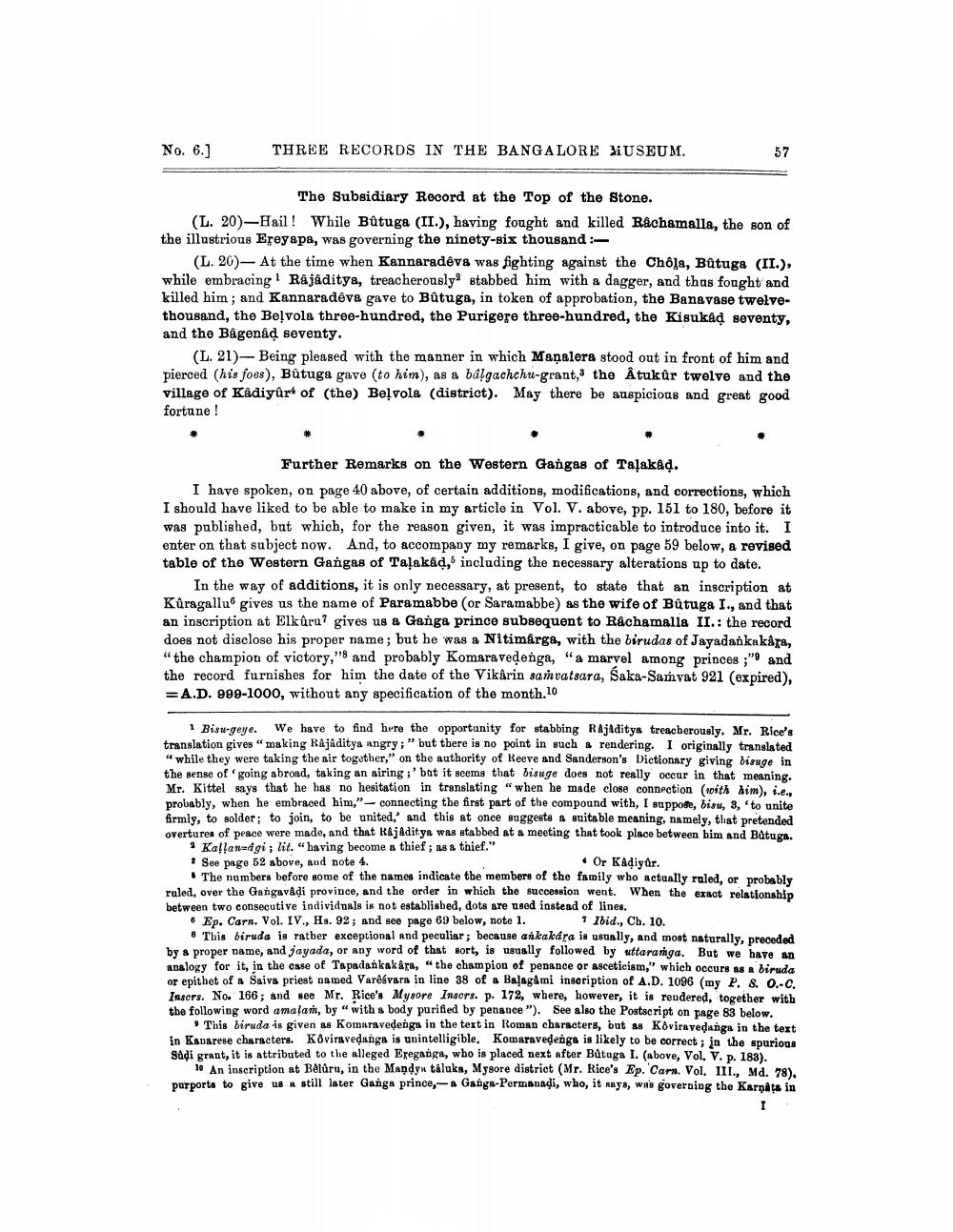________________
No. 6.)
THREE RECORDS IN THE BANGALORE MUSEUM.
The Subsidiary Record at the Top of the Stone. (L. 20)-Hail! While Butuga (II.), having fought and killed Rachamalla, the son of the illustrious Ereyapa, was governing the ninety-six thousand :
(L. 20)- At the time when Kannaradeva was fighting against the Chola, Bütuga (II.), while embracing! Råjåditya, treacherously stabbed him with a dagger, and thus fought and killed him; and Kannaradeva gave to Butuga, in token of approbation, the Banavase twelvethousand, the Beļvola three-hundred, the Purigere three-hundred, the Kisukad seventy, and the Bâgenâd seventy.
(L. 21)- Being pleased with the manner in which Mañalera stood out in front of him and pierced (his foes), Bütuga gave to him), as a bálgachchu-grant, the Atukur twelve and the village of Kådiyûr of (the) Beļvola (district). May there be auspicious and great good fortune!
Further Remarks on the Western Gangas of Talakad. I have spoken, on page 40 above, of certain additions, modifications, and corrections, which I should have liked to be able to make in my article in Vol. V. above, pp. 151 to 180, before it was published, but which, for the reason given, it was impracticable to introduce into it. I enter on that subject now. And, to accompany my remarks, I give, on page 59 below, a revised table of the Western Gangas of Talakad, including the necessary alterations up to date.
In the way of additions, it is only necessary, at present, to state that an inscription at Kûragallu gives us the name of Paramabbe (or Saramabbe) as the wife of Bûtuga I., and that an inscription at Elkûru? gives us a Ganga prince subsequent to Rachamalla II.: the record does not disclose his proper name; but he was a Nitimârga, with the birudas of Jayada kukara, "the champion of victory,''8 and probably Komaravedenga, "a marvel among princes ;"9 and the record furnishes for him the date of the Vikarin samvatsara, Saka-Saṁyat 921 (expired), = A.D. 999-1000, without any specification of the month.10
1 Bisw-geye. We have to find here the opportunity for stabbing Rajiditya treacherously. Mr. Rice's translation gives "making Rajâditya Angry;" but there is no point in such a rendering. I originally translated "while they were taking the air together," on the authority of Reeve and Sanderson's Dictionary giving bisuge in the sense of 'going abroad, taking an siringi' but it seems that bisnge does not really occur in that meaning. Mr. Kittel says that he has no hesitation in translating "when he made close connection (noith him), i.e., probably, when he embraced him," - connecting the first part of the compound with, I suppose, biru, 3, 'to unite firmly, to solder; to join, to be united,' and this at once suggeste suitable meaning, namely, that pretended overtures of peace were made, and that RajAditya was stabbed at a meeting that took place between bim and Batuga.
Kallandgi; lit. " having become a thief; as thief." * See page 52 above, and note 4.
Or Kadiyur. • The numbers before some of the names indicate the members of the family who actually ruled, or probably ruled. over the Gangav&di province, and the order in which the succession went. When the exact relationship between two consecutive individuals is not established, dots are used instead of lines.
. Ep. Carn. Vol. IV., Hs. 92; and see page 69 below, note 1. 1 Ibid., Ch. 10.
# This biruda is ratber exceptional and peculiar; because ankakára is usually, and most naturally, preceded by a proper Dame, and jayada, or any word of that sort, is usually followed by uttaranga. But we have an analogy for it, in the case of Tapadankakåsa, "the champion of penance or asceticism," which occurs as a diruda or epithet of a Saiva priest named Varesvara in line 38 of a Balag&mi inscription of A.D. 1096 (my P. 8. O.-. Insors. No. 166; and see Mr. Rice's Mysore Inscrs. p. 172, where, however, it is rendered, together with the following word amalam, by "with a body purified by penance"). See also the Postscript on page 83 below.
T hiruda is given as Komarovedenge in the text in Roman characters, but as Koviravedange in the text in Kavarese characters. K Oviravedanga is unintelligible. Komaravedenga is likely to be correct; in the spurious Sadi grant, it is attributed to the alleged Ereganga, who is placed next after Batuga I. (above, Vol. V. p. 189).
10 An inscription at Belura, in the Mandy taluka, Mysore district (Mr. Rice's Ep. Carn. Vol. III., Md. 78). purports to give us * still later Ganga prince,-a Ganga-Permanadi, who, it says, was governing the Karpata in




